|
A huge thanks to Scott at DragonShadow Industries for providing NUON-Dome with this exclusive look at the current state of Decaying Orbit, along with where the Yaroze port has been up to this point and where it's headed. Some very exciting news within, along with a new three-level demo, and a load of new screenshots (click to enlarge), so without further adieu...
Grab the latest Decaying Orbit demo here. Or from the new Decaying Orbit page. Some notes about this release: - The game has a lot of optimization forthcoming. The final game will be much faster.
- This demo only has the first three levels. After that the game will play level 3 over and over. Once I get the shops working I will release a new demo that lets you go further (level 4 is a shop).
- Controls are the same as given in my December 21st update. A quick summary:
- A - menu select
- C-left - menu exit
- A - thrust
- B - fire
- R+A - change engine system priority level
- R+C-down - change shield system priority level
- R+B - change laser system priority level
- R+C-left - change cooling system priority level
- After playing around with it for a while I've noticed quite a few things that need fixing. Don't bother sending bug reports yet. Let's wait until the game is more complete.
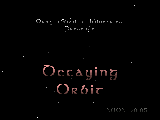 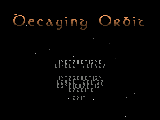 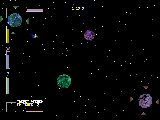 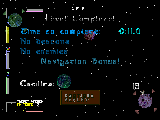 Decaying Orbit, a year later
-- by Skah T 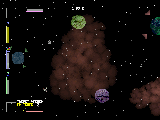 The NUON port of Decaying Orbit began on July 18, 2002 [link]. I felt it wouldn't be too difficult a job. At the time, the NUON sprite library already had most of the necessary pieces to accomplish the port. The idea was to create an API that would accept the standard Yaroze graphics calls from the game and translate them into NUON-speak. Not only would this allow Decaying Orbit to run largely unmodified, but any other sprite-based Yaroze games would be relatively easy to port as well. That was a year ago. What's happened in the intervening months? There are many reasons, but the bottom line is I'm a perfectionist.
The Initial Port
The first task was to create the Yaroze-to-NUON API. I started with the function calls necessary to get the initial Decaying Orbit splash screen. That happened pretty quickly [link]. Then I started writing code to handle the sprites. This was more involved since the sprites in Decaying Orbit are mostly 4-bit CLUT-based. Each one uses up to 16 colors which reference into a color lookup table (CLUT). There's a lot of other setup that is done before a sprite can be displayed. In October I had success [link].
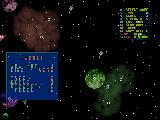 Over the following months I fixed bugs in, and added features to, the Yaroze-to-NUON API. Eventually it did most everything I needed to run the game. Unfortunately the game was dog slow. Resolute to create a perfect port I dove into the source code for the sprite library and started tweaking. Improvements to remove bottlenecks, optimizations to inner loops, and acceleration to often-called API functions. It still wasn't enough. I was only getting 12-15 fps on the first (and least complicated) level [link].
Who knows how slow it would run on the later levels? With some reluctance I lowered my goals and dropped the resolution from 640x480 to its current 320x240 [link]. The good news is that the game achieves a pretty solid 30 fps on the first level. We'll see how it holds up in the later levels. The bad news is all the sprites must be scaled down. Text in particular suffers from this down-sampling. Additional bad news is that the game is still not as fast as the Yaroze's 60 fps original. Thankfully, both of these problems can be addressed. Adding FeaturesRemember how I said that the NUON sprite library had most of the necessary pieces to accomplish the port? It was time to change that "most" into "all". 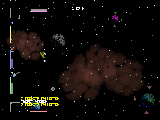 The biggest pain is the fact that NUON deals with pixels in a different color space than the Yaroze (YCrCb vs. RGB). Conversion between the two color spaces must be done per-pixel and takes a non-trivial number of CPU cycles. There's just no way around it. More recently I've been tweaking pixel renderers. The sprite library does a ton of stuff to set up each sprite before blasting the pixels out to the frame buffer. While the set up is done once per sprite, the drawing routines are run once per pixel. These are the so-called inner loops of the sprite library. Each one can be tailored for the specific capabilities needed for the sprite in question. That way you only do exactly as much work as necessary for that sprite. Saving a cycle or two in the inner loop has a tremendous impact since it is called for thousands of pixels. In addition to optimizing the existing renderers, I have also written my own. These custom renderers are designed to make the final pixel look just like the Yaroze. They check for transparency, apply translucency, and scale the RGB values of the pixel by given amounts [link].
With all these additions to the sprite library I started running out of RAM. Each processor (MPE) in the NUON chip has 4kB of memory for code and 4kB for data. With the existing renderers written and many more to come, there just wasn't room to fit them all. One of the last major improvements to the sprite library was to add a dynamic loader for the renderers. Basically each inner-loop is stored in main system memory, of which there is plenty. Then each sprite transfers the inner-loop that it needs from system memory to local memory at runtime. Now I can essentially have an unlimited number of renderers!
Present and FutureThat brings the story to the present. The Yaroze-to-NUON library has been stable for some time. The sprite library was enhanced to improve performance and is very solid. All of the features necessary for the game have been added, if a bit buggy. 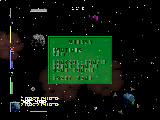 So what's next? The main thing is lots of optimizations. I will try my best to have the game run at a stable 30 fps throughout. This may be impossible, but I am a perfectionist after all. I will also need to enhance the original Decaying Orbit code to handle this reduced frame rate. Things will need to move & animate twice as fast to compensate. Then there's sound. That's a whole ball of wax I have yet to consider. It may be drop-dead easy if I can somehow find the file format for the Yaroze sound files. Failing that I will have to replace all the Yaroze API calls with NUON functions. I just don't know. I'll also try to get streaming background music working. Again, this could be easy or just plain impossible. While I don't consider it a must-have for the port I will include it if at all possible. One more major time consuming task will be to manually down-sample every single sprite image in the game. Then I can remove the requirement that the library scale everything automatically. Not only will this make things look better, it should give a performance boost since the current sprites have four times as many pixels as necessary. Less pixels to read == faster drawing 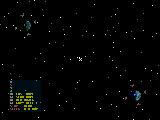 My goal is to be done with the port by the end of the year. This is more than just a hand-waving target. Sometime mid-January my wife and I are expecting our first little gamer in the family. He will make whatever free time I have now seem like a summer vacation. If the port isn't done by then it will likely be put on hold for a few months, and I don't want to put the NUON fans through that. But wait, that's not all! I have big plans for Decaying Orbit even after the port is done. It's too early to give away details, but I am just so freaking excited by what I have in mind! When it happens it will require the full support of the NUON community and then some. You'll read about it first here at NUON-Dome. In the meantime, follow the (somewhat) day-to-day progress through my development diary at DragonShadow Industries.
Cheers, thanks, and all that,
Scott Cartier (Skah T) 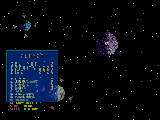 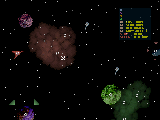 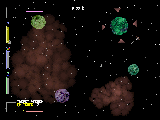
|
 Good news for NUON fans who plan on attending next year's PhillyClassic, (March 20 & 21, 2004). I've just purchased a table and have begun kicking around some ideas of what to do/display at the show. Here's what I've got so far:
Good news for NUON fans who plan on attending next year's PhillyClassic, (March 20 & 21, 2004). I've just purchased a table and have begun kicking around some ideas of what to do/display at the show. Here's what I've got so far: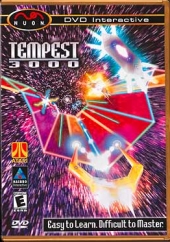 According to Jeff "Yak" Minter, it was accomplished at some point, along with a hacked PC Wingman Warrior controller with a rotary spinner, according to
According to Jeff "Yak" Minter, it was accomplished at some point, along with a hacked PC Wingman Warrior controller with a rotary spinner, according to 










